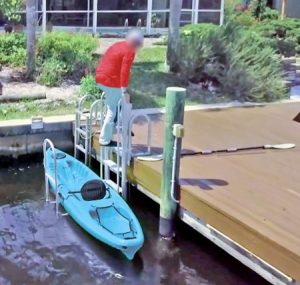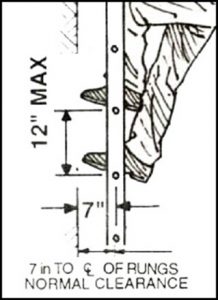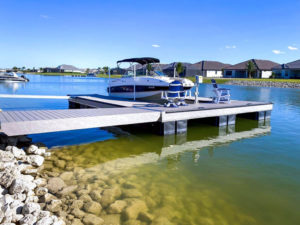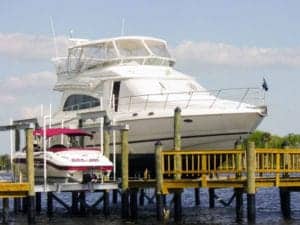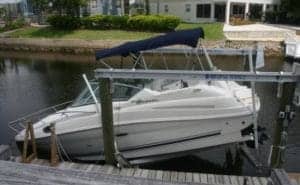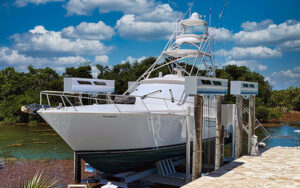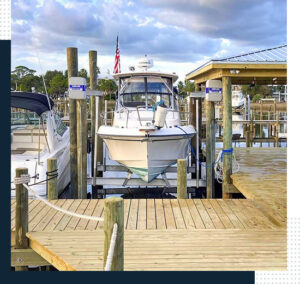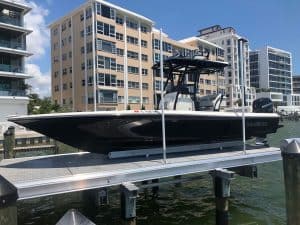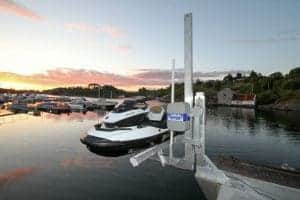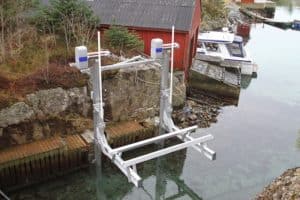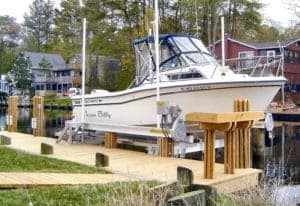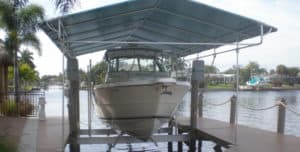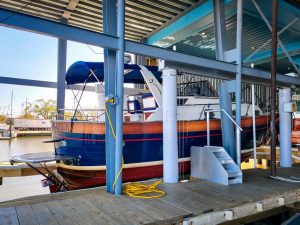The engineers at IMM Quality Boat Lifts have designed the safest and most comfortable kayak lift from scratch. Why? Last year, we took a look at the kayak lifts on the market and saw that they were all poorly designed. We performed our research, focusing on how we could make a kayak lift safer, easier and more comfortable for the human body. That is because we firmly believe that a product’s design and how it impacts the user is every bit as important as the quality of materials and construction. We consulted the OSHA requirements for ladders (29 CFR 1910.23) along with scientific articles on the ergonomics of ladder climbing.
Using this information, we created a radically different kayak lift. Please watch the video to see our boat lift in use and read on below to learn about the features that make the IMM Quality Boat Lifts kayak lift the safest and most comfortable on the market.
When climbing a vertical ladder, you must use both hands to climb up or down to maintain your balance (i.e. three-limb contact, two hands and one foot or one hand and two feet in contact with the ladder). Obviously, it is not safe to climb a vertical ladder with items in either hand. However, if you slant the ladder away from the vertical (the ideal ratio is 1” out for every 4” of rise), you will be able to maintain your balance, even if you let go of the ladder with your hands. Climbing an angled ladder is more natural, physically comfortable and consequently safer than a vertical ladder. That is why IMM Quality Boat Lifts designed our kayak lift with an angled ladder. Please see the images below showing the vertical ladders on two competitor’s kayak lifts.

Equally important to the use of a kayak lift is how easy it is to get on and off the ladder. According to OSHA, a ladder used to access an elevated surface must extend at least 3 feet above the surface to safely access the ladder from the surface. When fully lowered, our kayak lift design exceeds the OSHA guideline. Furthermore, all of the competitor’s kayak lifts have the rungs of their vertical ladders installed parallel to the dock or seawall. This configuration requires you to step around or to climb over the ladder when getting on or off (see images of competitors below). Our design has the rungs of the ladder installed perpendicular to the dock or seawall so that it is not in your way when getting on or off. This makes the IMM Quality kayak lift much easier and safer to use.

In addition, the ease of getting into the kayak from the ladder is another problem for our competitors. Descending a vertical ladder with your backside to the kayak is very awkward. To make boarding the kayak as easy as possible, we designed our lift with a large platform at the bottom of the ladder. This way you can turn and position yourself on the platform so that boarding the kayak is easy and comfortable.
What do our competitors’ customers do with items they want to bring with them while kayaking? Maybe you want to bring some drinks or snacks? Or your photography gear? How about your fishing gear? There are so many different things a kayaker may want to bring with them. Do you risk a fall injury carrying your items in your hand as you use the vertical ladder? Or do you put the items into the kayak before lowering the lift, potentially tipping the kayak off the short bunks?
This is another reason why we designed our lift with a large platform. Simply place your items on the platform while you lower the lift. What about your paddle? Some competitors didn’t even bother to include paddle hooks (see image below) forcing their users to place the paddle up on the dock while seated in the kayak. What if your dock is too high above the water to reach? We made sure to include paddle hooks on our lift.
Then there is the ergonomics of using the hand winch. Our competitors installed the hand crank low to the ground (see images below), forcing their users to bend over while lowering and raising the lift. I can already feel the pain in their lower backs. We installed the hand crank at waist height (36”), allowing our customers to maintain a comfortable standing position while raising or lowering the lift. Furthermore, if hand crank winches are not your thing, you can upgrade to an electric winch that runs off solar power with the IMM Quality kayak lift.

There are numerous other OSHA guidelines for which our competitors’ kayak lifts are non-compliant (see below). You might be thinking that you will be installing the kayak lift at your home, so it is not subject to OSHA guidelines. First of all, the primary objective of the OSHA guidelines is safety. Make the equipment around us operate in a safe, natural and physically comfortable manner, thereby decreasing fatigue and lowering the risk of injury. The safety and comfort of our customers is paramount, and this principal is reflected in our designs. Secondly, many municipalities have adopted OSHA guidelines into their code. A careful inspector will notice that your ladder is not code compliant. Finally, you may want to rent out your property with VRBO or AirBNB. This commercial use of your property would likely make your lift subject to these rules.
The following is a short list of OSHA guidelines that we noticed were non-compliant with some of our competitor’s kayak lifts:
- Rungs and steps shall be corrugated knurled, dimpled, coated with skid-resistant material, or otherwise treated to minimize the possibility of slipping.
- Rung Spacing: 10″ minimum and 12″ maximum spacing from centerline to centerline of rungs.
- Rung Width: The minimum clear width of rungs on fixed ladders shall be 16″
- Side Clearance: For 90 degree (vertical) ladders, there shall be 30″ of clear space to both sides of the ladder (Obviously this depends on the install, but the lift pictured with the blue kayak appears to fail this rule).
- Back Side Clearance: The distance from the center-line of rungs to a permanent object behind the ladder (i.e. a seawall or dock stringer) shall be 7″ minimum (Both kayak lifts shown in this post fail this rule, see figure below).
Explore IMM Quality Kayak Lifts
We hope that you found this post informative. Have we convinced you that our engineers have designed the safest and most comfortable kayak lift on the market? If you would like more information about the IMM Quality Kayak lift, please visit our product page or contact our sales staff at (800) 545-5603.
Feeling inspired by this feat of design, engineering and manufacturing? Complete our CONTACT FORM or REQUEST A QUOTE and we’ll give you a call!
READ MORE: We’re Ready to Deliver Worldwide!




